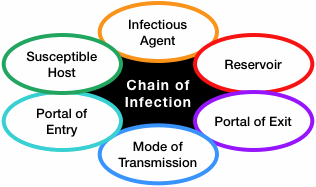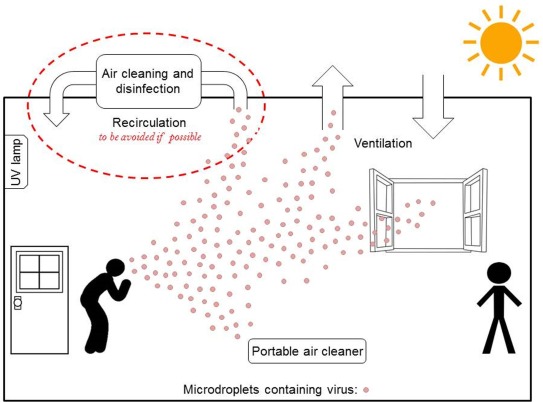MEDICAL & SURGICAL ASEPSIS
- ASEPSIS: Asepsis is the state of being free from disease causing microorganisms such as bacteria, viruses, pathogenic fungi, and parasites.
- Aseptic technique: It is a standard health care practice that helps to prevent the transfer of germs to or from an open wound and other susceptible areas on a patient’s body.
- A technique used the practice and procedure to prevent contamination from pathogens.
Purpose: a septic technique helps to prevent health care associated infection.
- Using aseptic techniques prevents the spread of infection by harmful germs.
- Disinfecting a patient’s skin using antiseptic wipes.
- Sterilizing equipment and instruments before a procedure.
- Keeping sterilizing instrument inside plastic wrappers to prevent contamination before use.

Types of Aseptic Technique
- There two types of techniques
- Medical asepsis (“clean technique”): practices that kill some microorganisms to prevent them from spreading.
- Surgical asepsis (“sterile technique”): practices that completely kill and eliminate microorganisms.
Medical or clean asepsis reduces the number of organisms and prevents their spread; surgical or sterile asepsis includes procedures to eliminate microorganisms from an area and is practiced by surgical technologists and nurses.
IDENTIFY THE 6 COMPONENTS OF CHAIN OF INFECTION
The spread of an infection within a community is described as a “chain,” several interconnected steps that describe how a pathogen moves about. Infection control and contact tracing are meant to break the chain, preventing a pathogen from spreading.
The transmission of infection depends on six elements which link together like chains.
The Spread of infection can be described as a chain with six components.

- Infection agent (Pathogen)
- Reservoir (the normal location of pathogens)
- Portal of exit from the reservoir
- Mode of transmission
- Portal of entry into a host
- Susceptible host
If any link is broken the chain is broken and infection cannot be transmitted.
1. The Infection Agent
(Pathogens) include not only bacteria but also viruses, fungi, and parasites. The virulence of these pathogens depends on their number, their potency, their ability to enter and survive in the body, and the susceptibility of the host. For example, the smallpox virus is particularly virulent, infecting almost all people exposed. In contrast, tuberculosis bacillus infects only a small number of people, usually people with weakened immune function, or those who are undernourished and living in crowded conditions.
Any disease-causing microorganisms (bacteria, virus, fungi, parasites etc).
2. The Reservoir
A reservoir is any person, animal, arthropod, plant, soil or substance (or combination of these) in which an infectious agent normally lives and multiplies. The infectious agent depends on the reservoir for survival, where it can reproduce itself in such manner that it can be transmitted to a susceptible host.
Where the germs normally live e.g. person, water, food, animal, plant, soil or substance feces, intravenous fluid, and equipment in which an infectious agent normally lives and multiplies.
3. The Portal of exist
A portal of exit is the means by which a pathogen exits from a reservoir. For a human reservoir, the portal of exit can include blood, respiratory secretions, and anything exiting from the gastrointestinal or urinary tracts.
Route by which the infectious micro-organism escapes or leaves the reservoir,
- Excretions
- Secretions
- Skin
- Droplet flue cold 🡪 mucous secretions
4. The Mode of transmission (Spread) route
People release respiratory fluids during exhalation (e.g., quiet breathing, speaking, singing, exercise, coughing, sneezing) in the form of droplets across a spectrum of sizes. These droplets carry viruses and transmit infection. The largest droplets settle out of the air rapidly, within seconds to minutes.
The way of the pathogen gets from the reservoir to the new host. For example: –
Route of transmission from respiratory tract (Nose, Mouth)
Secretion of infected person, Example: – Cough and sneezing.
Droplet transmission
Agent is coughed or sneezed out into the air
and floats on droplets.

Direct spread by droplets:-
- Close contact with infected person (<3ft)
- Infected person coughs, sneezes, talks, sings,
- Droplets land directly on mucous membranes.
- (Eyes, Nose, Mouth) of susceptible person
Indirect spread by droplets: –
Someone touches contaminated object.
🡪Inhalation (e.g. Respiratory tract)
🡪Ingestion (e.g. GI tract)
🡪Absorption (e.g. mucous membranes of eyes)
🡪Break in skin (e.g. Needle stick, Cut).
🡪Interaction by medical procedure (catheter).
5. The Portal of Entry
Infectious agents get into the body through various portals of entry, including the mucous membranes, non-intact skin, and the respiratory, gastrointestinal, and genitourinary tracts. Pathogens often enter the body of the host through the same route they exited the reservoir, e.g., airborne pathogens from one person’s sneeze can enter through the nose of another person.
The route through which the pathogen enters its new host
- Inhale germs
- Sexual contact
- Breaks in protective skin barrier
- Ingestion
The Susceptible host
The final link in the chain of infection is a susceptible host, someone at risk of infection. Infection does not occur automatically when the pathogen enters the body of a person whose immune system is functioning normally. When a virulent pathogen enters an immune-compromised person, however, infection generally follows
A person who can get sick when exposed to a disease-causing pathogen.
- Children who are very young.
- People are on inadequate diets.
- People who are chronically ill
- People receiving medical therapy such as chemotherapy or high clothes.
- People who are already ill.
- People who open wounds.
- If the chain is not broken the infectious organism is able to go on to develop disease in another person.
How to break the chain of infection?
- Hand sanitizing and hand hygiene.
- Cough and sneeze etiquette.
- Proper use of personal protective equipment.
- Sharp management.
- Appropriate disposal of waste
Ways that infection may occur.
Three things are necessary for an infection to occur: Source: Places where infectious agents (germs) live (e.g., sinks, surfaces, human skin) Susceptible Person with a way for germs to enter the body. Transmission: Way germs are moved to the susceptible person.
- Infectious disease can spread in a variety of ways.
- Through air, from direct or indirect contact
with another person, Soiled objects, skin or mucous membrane, saliva, urine, blood, and body secretions through sexual contact and through contamination of food and water.
Factors that increase the risk of infection: –
- Diminished immune response.
- Advanced age.
- Malnutrition.
- The presence of multiple chronic diseases.
- Cognitive deficits, basic sanitary practices
(Hand washing).
- Functional impairment such as incontinence or immobility.
- Use of invasive devices like Catheters, ventilators, feeding tube.
- Diminished ability to complain of or self-identify symptoms, or increased likelihood of presenting with atypical symptoms or signs of infection.
EXAMPLE OF HOW INFECTION OCCURS
- Example of common cold.
- Any infection follows the same steps as that of chain of infection starting from infectious agent to susceptible host.
- A flu virus deposited into the front of the nasal passages by contaminated fingers or by droplets from cough and sneezes.
- Small dose of virus(1-30 particles)are sufficient to produce infection.
Role of health care personnel in infection control
Introduction to patient safety
- Definition: patient safety is a discipline in the health care sector that applies safety science methods toward the goal of achieving a trust worthy system of health care delivery.
- Patient safety is also an attribute of health care system ,it minimize the incidence and impact of adverse events and maximizes recovery from health problems.
Health care associated infection (HAI)
According to who:
- HIA is also called nosocomial infection.
- HIA is defined as:
An infection acquired in hospital by a patient who admitted for a reason other than that infection.
An infection occurs in a patient in a hospital or other health care facility in whom the infection was not present or incubating at the time of admission.
Impacts of Nosocomial infection (HIA)
- Increase patients suffering.
- Lead to permanent disability.
- Lead to death.
- Prolonged hospital stays.
- Increase need of higher level of care.
- Increase the costs to patients and hospitals.
Prevent from infections
Requires health care provider who have to,
– Knowledge of common infections and their vectors.
– An attitude of cooperation and commitment.
– Skills necessary to provide safe care.
-use universal precautions.
– Knowledge about the extent of the problem.
– Knowledge of main causes, modes of transmission and types of infection.
Universal precautions
Definition: universal precautions are a set of precautions designed to prevent transmission of HBV, HCV, HIV and other blood –borne pathogens while providing healthcare to all patients regardless of their diagnosis or presumed infection status.
Standard precautions:
Are the precautions to be used by all health care workers in all situations involving the care of patient of contact with the environment.
- Hand hygiene
- Gloves, apron/ gown, footwear.
- Mask, eye protection and or face shield.
- Preventing occupation Exposure.
- Accommodation patient placement isolation.
- Environment
- Laundry
- Blood and body fluid spillage
- Clinical waste.
Nursing student needs
- To apply universal precautions.
- To be immunized against hepatitis B
- To Use personal protection method
- To know what to do if expose
- They encourage others to use universal precautions.
